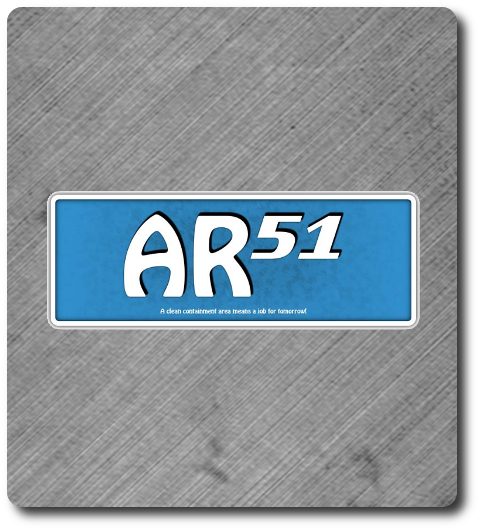
The Basics:
- For ages 8 and up (publisher suggests 12+)
- For 2 to 4 players
- Variable game play length
Geek Skills:
- Counting & Math
- Logical & Critical Decision Making
- Reading & Writing
- Risk vs. Reward
- Hand/Resource Management
- Area Control
Learning Curve:
- Child – Easy
- Adult – Easy
Theme & Narrative:
- Protect Earth from invasion one secret hangar at a time
Endorsements:
- Gamer Geek rejected!
- Parent Geek mixed!
- Child Geek mixed!
Overview
Let’s be clear. Your job does not exist. Your employer does not exist. Those alien artifacts and technology you see over there. Those doesn’t exist either. Yes, you exist. Don’t be silly and don’t let your control area get out of .. well .. control. We like to keep things clean and organized here. And by “we”, I mean no one. Now get to work, Agent.
AR51, designed by Tom Bradley and published via the Game Crafter, is comprised of 103 cards. The cards are as thick and as durable as your standard playing card. The artwork is minimal, favoring big type and simple symbols to communicate information to the card holder.
Preparing for the Job
To play the game, first look through the deck of cards and remove the Containment Area cards. These cards have a blue face and the phase “Containment Area” listed underneath an arching eye symbol. Give each player 5 Containment Area cards that should be placed directly in front of them in a row, face-up. These represent the 5 different containment storage areas the player is responsible for. Return any Containment Area cards not used back to the game box.
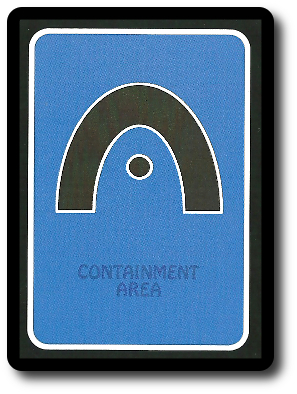
Second, shuffle the remaining cards and then deal each player 5 cards, face-down. This is the player’s starting hand. Players should look at their cards but keep them hidden until played.
Third, place the remaining cards in the middle of the playing area, face-down. This is the draw deck for the duration of the game. Leave room for a discard pile.
That’s it for game set up. The player left of the Dealer goes first.
The Right Tools for a Strange Job
Not including the Containment Area cards each player was given during game set up, there are a total of 4 types of cards the players will use in the game. These cards are played from the player’s hand and are summarized here.
Ability Cards
Ability cards are played to Containment Area cards. When placed, the Ability card affects all the cards located under the Containment Area card immediately. A Containment Area card can only have 1 Ability card at a time and Ability cards can only be discarded or moved by way of an Action card. Once an Ability card is removed from the Containment Area card, any bonuses or penalties it provided are removed, as well.
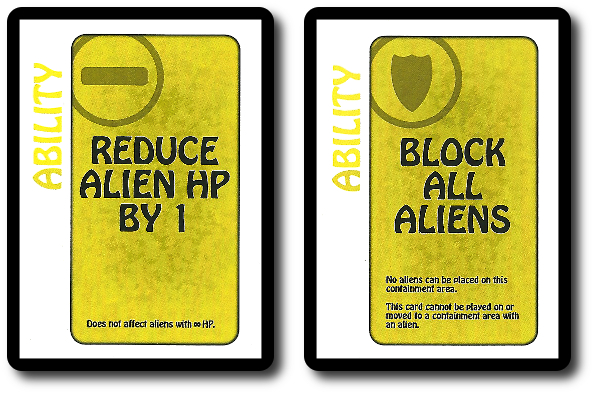
Action Cards
Action cards have 2 primary purposes. First, they allow the player to move Ability and Alien cards. Second, Action cards allow the player to draw and play additional cards past their normal limits. Once played, Action cards are read out loud, resolved, and then discarded.
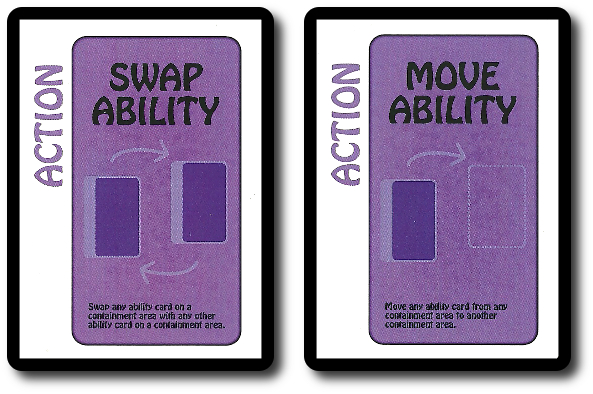
Alien Cards
Like the Ability cards, only 1 Alien card can ever be located in a Containment Area at a time. Alien cards can be removed from a Containment Area card through Action cards or through the process of “liquidation”. Players do not want too many Alien cards or they run the risk of being fired (i.e. “losing the game”).
Alien cards list the alien’s health points (HP). If the Alien card is attacked enough times where the total of the sustained damage is equal to or higher than the alien’s health points, it expires. Consequentially, the remains of the alien must be “liquidated” to ensure the existence of the alien is never known.
There are a few Alien cards that list the health points with an infinity symbol instead of a number value. These aliens are immune to normal damage and can only be liquidated if an Attack card with the same symbol is used or by way of a nuclear explosion (which is only possible with the “Core” and “Detonator” Attack cards). That’s one tough alien! Consequentially, using a nuke will also remove ALL Alien cards from the player’s Containment Area cards. Not too shabby.
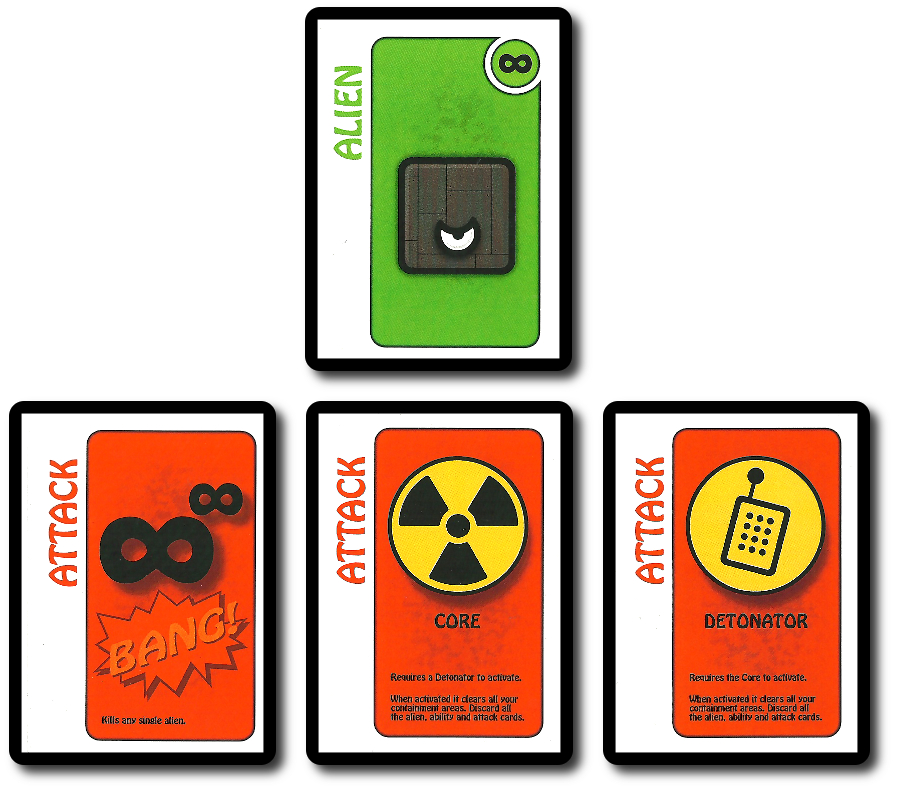
Attack Cards
Attack cards are used to attack the alien’s under the player’s Containment Area cards. Some aliens have enough health points to withstand the damage sustained by 2 or more Attack cards. In which case, the Attack cards remain on the targeted Containment Area card until such time the Alien card is liquidated.

If an Alien card is moved from one Containment Area card to another, the Attack cards are moved with the Alien card. As such, players cannot avoid or heal damage by relocating an Alien card.
Keep it Clean, Keep it Safe
AR51 is played in turns with no set number of turns per game. A player has 2 options on their turn. Each option is summarized here.
Option 1: Play 2 Cards
Any card the player has in their hand can be played.
- Play an Alien card to a player-owned Containment Area card that does not yet have an Alien card located under it.
- Play an Ability card to a player-owned or an opponent-owned Containment Area card that does not yet have an Ability card located under it.
- Play an Attack card to a player-owned Containment Area card that has an Alien card located under it.
- Play an Action card and resolve its effects by moving Alien cards to an opponent’s Containment Area or some other offensive/defensive action.
Option 2: Discard 2 Cards
The player selects 2 cards in their hand and places them face-up in the discard pile.
When the player is over, they draw or discard back to 5 cards. It’s now the next player’s turn.
Winning or Losing the Employee of the Month Award
If a player ever ends their turn with 5 Alien cards (meaning each of their Containment Area cards has 1 Alien card), they have been overrun with aliens resulting in a very negative review from their superiors. The are now suspended without pay and have lost the game. All cards the player had under their Containment Area cards and in their hand are placed in the discard pile.
The winner of the game is the last player still remaining. They have proven to their superiors that they can make command decisions under pressure and keep their area of responsibility free and clear. Well done, Agent! Your first mission is to clean up the game…
House Rules
A large number of our players were not happy with the game’s rules. Several House Rules were developed to improve the game play for those who still wanted to enjoyed AR51. I’m sharing the more popular ones here. Feel free to use or modified them as you like.
Initial Alien Invasion
After players are dealt their initial 5 cards, any Alien cards in their hand are played to their Containment Area cards. Then the player draws back up to 5 cards. If they draw more Alien cards the second time, the Alien cards remain in their hand. This initial seeding of Containment Area cards may feel that it tips the balance of the game, but Alien cards can be moved about. What this House Rule does is automatically provide a higher level of threat to all the players in the game.
Alien Toughness
Alien cards cannot be discarded, but nor do they have to be played. This will allow a player to keep their Alien cards in their hand, but the only way to get rid of them is by playing them. The longer the player keeps them Alien cards, the longer they reduce the number of Action, Ability, and Attack cards they can hold due to the hand size limit.
Aliens in the (Full) House
If the player ever has 5 Alien cards in their hand (other than their initial hand), they must show their cards and are out of the game. This House Rule forces a player to play Alien cards and to manage 2 levels of threat. The threat of their Containment Area cards being overrun and their hand of cards being taken over.
To learn more about AR51, visit the game’s web page.
Final Word
The Child Geeks had difficulty understanding why a player would place Alien cards on their own Containment Area cards. When I explained that the “Aliens have to start somewhere”, they begrudgingly agreed to play by the game’s rules, which is always a good thing. It didn’t take long until the older and more experienced Child Geeks started to see the inherent problem of playing bad cards that could hurt you in hopes of using them to hurt opponents. According to one Child Geek, “It’s all about risk. Do I bring out as many Alien cards as I can to later move them or do I keep my area as Alien free as possible so I can remove the Aliens my opponents send to me?” More times than not, the Child Geeks opted to play defensively, keeping their own Containment Area cards free and clear of alien scum. This made several of the games last a lot longer than any of the player’s thought it should. As one Child Geek put it, “The game seems to take forever.” The Child Geeks then shifted tactics and ganged up on other players, which worked, but it always left 2 players looking at each other without the means to do much. What it always came down to was the cards. If the Child Geek had good cards, they did well. If not, they were alien sucker punched. This left the Child Geeks with mixed feelings about the game, which resulted in a mixed level of approval.
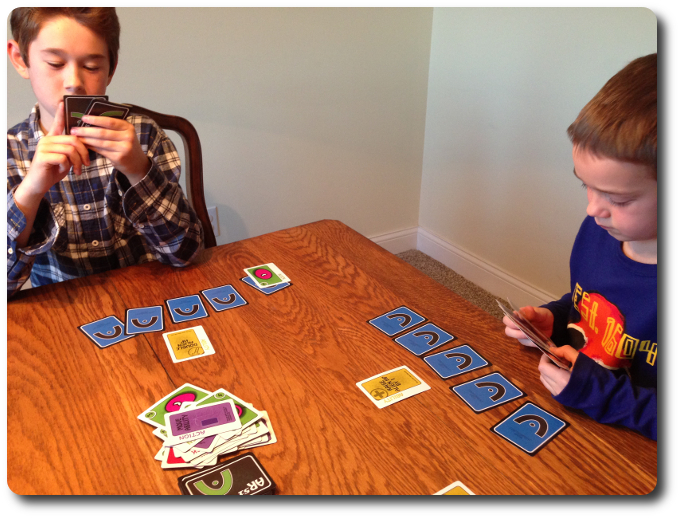
Round 2 and my two oldest sons have learned that the best defense is to crush Dad as a team
The Parent Geeks liked the idea of the game a great deal. According to one Parent Geek, “I really like how you have to play the cards that are meant to hurt opponents to yourself first. It makes you pause and consider your tactics.” But as the Parent Geeks learned, and the Child Geeks already knew, the cards in hand dictate much of what the player will do on their turn. Further more, how well they can defend against other players. And like the Child Geeks, the Parent Geeks learned that the best way to remove a player from the game was to flood them with aliens by having multiple opponents target their Containment Area cards at the same time. Such an onslaught cannot be dodged or avoided. While this method of player removal worked brilliantly, it always resulted in 2 players remaining, playing a game that took longer to finish than anyone expected. As one Parent Geek said, “This game works great when there are a lot of players, but gets really sluggish when players aren’t aggressive or cannot be aggressive.” Some of the Parent Geeks enjoyed AR51 enough to approve it, while some thought it was a good idea in theory, but didn’t play well at the table.
The Gamer Geeks, liked the Parent Geeks, were intrigued by the game’s concept and the idea that the players needed to play bad cards on themselves before moving them to an opponent’s area. Then the Gamer Geeks broke the game. Turns out all it took was for every player to always discard their Alien cards. This resulted in the game going nowhere. I argued that this act of discarding Alien cards went against the spirit of the game. One Gamer Geek responded curtly, “Wrong. If the rules say I can, then it’s well within the limits and the so-called spirit of the game. This game is broken.” A number of Gamer Geeks agreed. One Gamer Geek said, “Without forcing the player to play at least 1 Alien card per round, the game never advances.” The Gamer Geeks found the game to be boring and broken. It came as no surprise that the gaming elitists rejected AR51.
There was a great deal of discussion among our players regarding the use of the Alien cards. They are a means to the endgame, but by no means are the players required to use them. This felt wrong to many of our players. Even a small number of our Child Geeks felt it was strange that you could discard Alien cards. While I won’t go so far as to suggest that Ar51 is a broken game, I did find the option of discarding Alien cards out of hand to be eyebrow raising.
A player’s priorities in the game are very clear: keep your area clean. Placing Alien cards in the area is counterintuitive and feels wrong right from the start. I personally found this to be a sneaky way of challenging the player to consider good card combos and timing, but more times than not it resulted in the players not playing Alien cards at all. If they had 2 to 3 Containment cards occupied by Alien cards, they never played an Alien until they removed the ones they currently owned. Not a bad thing, but it stopped the game from going forward. Luckily, there was a solution.
The solution, however, was anything but nice and did not resolve some of the issues the player’s hand. To win the game, you have to flood an opponent with Alien cards so they become overwhelmed and unable to clean their area. This is only possible if 2 or more players target the same opponent. If that happens, down they go. But that’s where the problems start. In a 4-player game, 3 players can take out 1 player fairly easily. When 2 players target 1 player, it’s just as easy, but less fast. When there are only 2 players, the game grinds to a halt and victory is based on luck and good cards. Pretty anticlimactic.
I didn’t find the game boring, but I did find that it never really took off. Progress is only made when you swamp an opponent. If you can only add a little risk at a time, it’s easy to manage said risk. There was the threat of risk, to be sure, but it never manifested until players teamed up and took out a single target. Which, again, is pretty anticlimactic.
This was not a game for me. I liked the concept of AR51, but didn’t feel that its execution made for a game that made me want to play it. I don’t think it would take much to make it a game that was more engaging, however. The House Rules helped a great deal by forcing confrontation, risk management, and player interaction. As it plays today, you can sit back and not do anything. Which really isn’t a game I want to play.
This game was given to Father Geek as a review copy. Father Geek was not paid, bribed, wined, dined, or threatened in vain hopes of influencing this review. Such is the statuesque and legendary integrity of Father Geek.




Funny how a single missing word drastically changes the game. I am correcting the rules so others can play the game as it should be. It is true, we learn more from our mistakes.